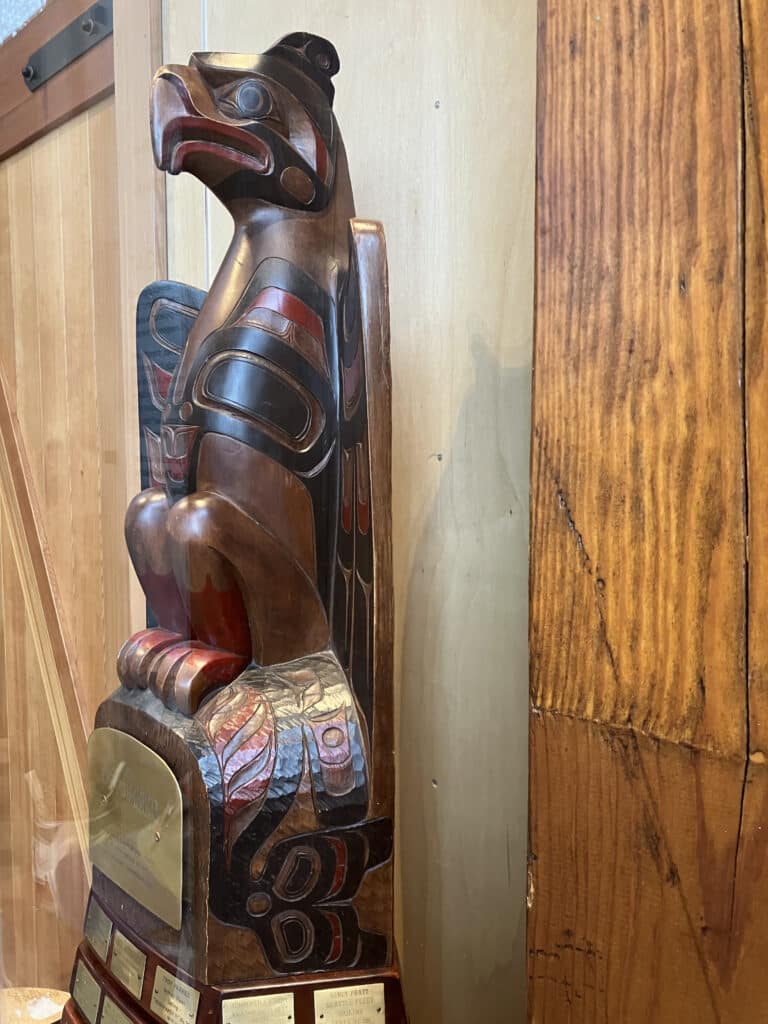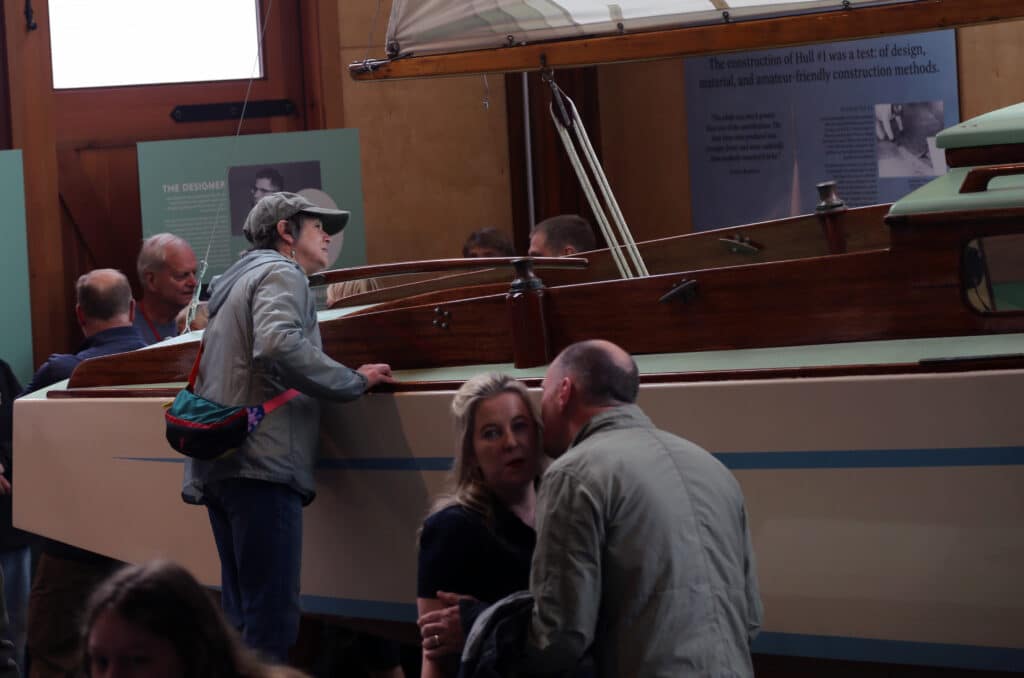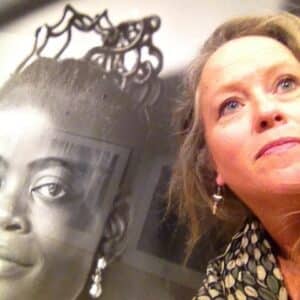Community
Out of the Archives | Accidentally discovering the carver of the Thunderbird International Race Trophy
Editor’s note: Harbor History Museum Executive Director Stephanie Lile is authoring an occasional series of articles providing more in-depth information on items in the museum’s collection. The first is about a carving whose creator was a mystery until recently.
Community Sponsor
Community stories are made possible in part by Peninsula Light Co, a proud sponsor of Gig Harbor Now.
From its sweeping wingspan to its elegant Northwest Coast form-line design, the Thunderbird International Race Trophy now has a new permanent home at the Harbor History Museum.
First presented to race winner Bob Johnson (San Diego Fleet) at the August 1966 International Thunderbird Regatta held in Seattle, the trophy’s origin was a bit of a mystery. From that original win, the trophy has passed to some 28 winners of the “Worlds” over the following 59 years. Each winner is memorialized on an engraved brass plaque attached to the base of the trophy.
Yet the identity of the distinctive trophy’s carver was lost to the decades. Until now.

The Thunderbird International Race Trophy at the Harbor History Museum.
Standing some three feet tall on a layered base, the trophy now looks majestically over its inspiration, Thunderbird Hull #1. Number One, as the 26-foot sailboat is often called, was designed by naval architect Ben Seaborn and built here in Gig Harbor by noted boat builder Ed Hoppen.
Launched in 1958, this boat was unique for its day, being built of a “new” material — marine plywood — in response to a challenge broadcast by the Douglas Fir Plywood Association. Could a boat be designed that was built of plywood, could sleep four, versatile enough to cruise or race, and be built at home by the amateur boat builder? The answer was yes, and the challenge spawned the International Thunderbird Class Association (ITCA).
Gig Harbor was the original epicenter of the club. But with the Plywood Association selling more than 15,000 sets of Thunderbird plans in the first decade of their release, fleets began appearing across the globe. By the mid-1980s, the international race brought boats from Japan, Australia, Seattle, and Boston.

Maritime Gallery visitors look inside the Thunderbird No. 1 during the opening of the Harbor History Museum’s Maritime Gallery on April 26. Photo by Vince Dice
Grant Chyz, the most recent winner of the Worlds and local ITCA member who coordinated the establishment of the trophy’s permanent home, has won the trophy four times (1991, 1993, 2017, 2023). “We know the race winners from the plaques,” he said. “But I’ve looked all over the trophy for clues to the carver with no luck.”
It’s unusual these days for a carver NOT to leave his or her mark. Skilled carvers of Northwest Coast art are rare even here in the Pacific Northwest. Museum staff believed that somewhere in the many boxes of ITCA archives the carver’s identity would be revealed. You don’t make a trophy of this size, distinction, and intention without it being a big deal.
Grant and his wife even came down to go through numerous boxes of records from the 1960s and 1970s. The closest lead they revealed was a reference to carver Tony Hunt. And yet there are two: Tony Hunt Sr. and his son Tony Hunt Jr. Both were Kwakwaka’wakw carvers and artists of extraordinary talent and reputation. The timeline of the carving (1965-66) would have tied it to Tony Hunt Sr., but the hard evidence was admittedly weak.
When you write an exhibit label, the space is limited, text is short and must be precise. Phrases such as “believed to be” or “may be attributed to” are necessary when hard facts are as skittery as sow bugs running from the light. Sometimes it takes one last-ditch effort to find that piece of evidence that reveals the history of an object with indisputable clarity.
That piece of evidence had eluded us for months. But miraculously, when I went back to take a second look at the ITCA materials, I pulled the “wrong box.” What I found instead was Box No. 238 that held newsletters from 1965-66. In among the abundance of files was one labeled “Worlds.” In that was the glowing evidence we’d long been searching for. A photocopied page from a magazine showed a picture of the trophy along with a short explanation of its origin.
“Bill Holm, well known expert on the culture of the Indians of the Pacific Northwest and also an expert carver who uses their traditional methods, was commissioned by the International Thunderbird Class to create the trophy. The beautifully carved Thunderbird is an authentic Vancouver Island Indian style out of an Alaska cedar log which Bill found on a beach in the San Juan Islands.” — SEA and Pacific Motor Boat, August 1966
Holm (1925-2020) is the author of Northwest Coast Indian Art, one of the first books on form-line design published by University of Washington. He was the inspiration for the new Bill Holm Center at the Burke Museum in Seattle. His scholarship and skills were highly revered by both indigenous and non-native peoples.
To have a Holm carving in the Harbor History Museum is a rare and special gift for all. It not only tells the story of a unique boat that had many traits of the mystical thunderbird, it bridges cultures of land and sea. The trophy has been held by race winners from Sydney, Australia to Ontario, Canada and from San Diego to Seattle. The Harbor History Museum is proud to be the new home of both the International Thunderbird Trophy as well as the newer regional trophy, also carved in the Northwest Coast style. The carver of that trophy still remains a mystery.
To learn more about Bill Holm and Formline design watch this lecture by Holm from 2006.
See the “Holm Thunderbird” at the Harbor History Museum, open from 11 a.m. to 4 p.m. Wednesdays through Saturdays.

Stephanie Lile
Stephanie Lile, M.Ed, MFA has been the director of the Harbor History Museum since 2017. She’s an almost life-long resident of Gig Harbor and is a champion for historic preservation, cultural arts, and interdisciplinary learning. Her museum background scales large to small museums, from Vermont to Washington, DC, and Los Angeles. An avid researcher, Lile has published articles in numerous publications including Columbia Magazine, This Place, and Museum. Although she still dreams of being a National Geographic explorer, she currently applies that intensity to research on objects in the museum’s collection and beyond.


